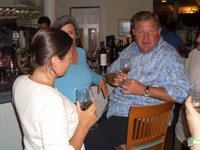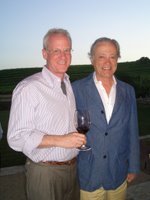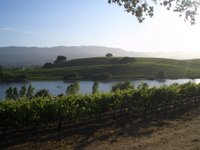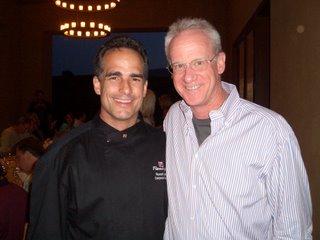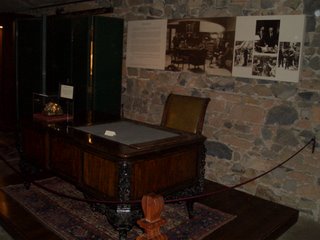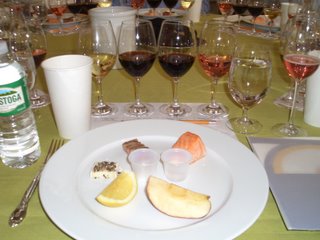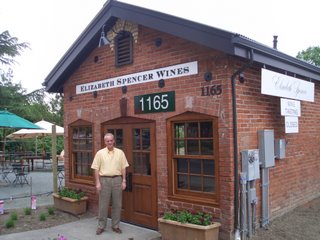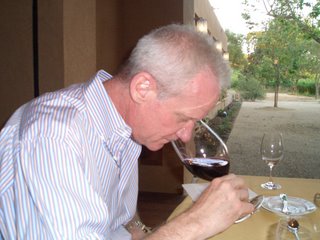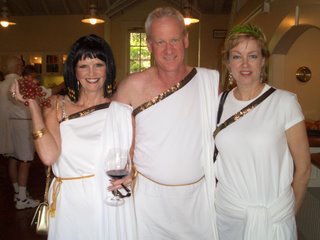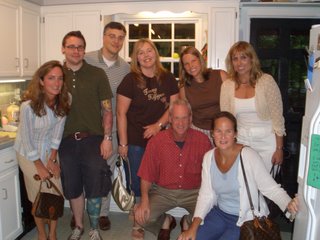Arrived safely in Oakland after a nice day for flying across this great country. A couple hour layover in Dallas yielded a great new Mexican restaurant over in Terminal D, where I slugged down the requisite margarita with my Chimichunga. Cabbed to the
Claremont in Berkeley where my room was not quite ready but allowed me the opportunity to try a nice California Sauvignon Blanc on the terrace looking overlooking the Bay toward San Fran and the Golden Gate Bridge.
Dinner was scheduled for 6:30 at
Chez Panisse. Grabbed a cab about 6, and wove through the UC - Berkeley Campus, which is lovely and great for people watching. My friends Brad and Roger ran a bit late due to traffic but I took the time to browse through the latest copy of "The Onion", a sarcastic newspaper with some great humor and observation. As I waited in the trendy restaurant, I ordered a glass of ros
e Bandol from France, dry and crisp with just the right acid to match the olive snack placed on the table. I knew this was not going to be a week of much old world wine, so I was going to try to sneak them in whenever I could. Plus it's always fun to watch people's reaction when you have a pink wine on the table. Little do they know...
When the boys arrived, we got down to business, beginning with Roger's choice, a
Littorai Thierot Vineyard Chardonnay. This gem was made in the classic tradition of Burgundy, so came across like on of the great Chablis premier crus. Crisp and well balanced with a little toast and wonderful mineral flavors that the North Coast of California is able to impart, if the winemakers will allow it to emerge. Our food pairings for this wine began with a warm shrimp salad with basil and scallions. Always the hardest wine pairing course because if the vinegar, this salad was light and fresh with that great mouth feel of warm/cool of the shrimp and local greens. A nice balance was provided by the chardonnay in that the vinegar was merely hinted in the dressing.
Next two soups, a fava bean puree and carrot with tarragon cream were combined in one bowl, the colors dividing in half like a more straight line Ying Yang symbol. We all noted how the carrot seemed so fresh that there was none of the cloying sweetness that seems to pervade carrot dishes and the hint of tarragon brought the wines more aromatic nuances out. The fava bean side was, in quoting Roger: "Fava Bean". Kind of bland, but I pulled out what was left of my French Bandol, and VOILA, the slight earthiness of the dry ros
e was a much better pairing, bringing out the earthy note of the bean. Score one for the old world again.
Brad brought along a '96 Burgess Family Barossa Shiraz, 95 points from Mr. Parker, and we now poured that for the main course. I think we were all concerned about the rock crusher Aussie style conflicting with the next offering, a chicken ballotine and breast with wild mushrooms, spinach and asparagus. However we were all pleasantly amazed with the smooth velvet that poured across our palates. Classic nose of white and black pepper, but none of the astringent tannins which can overwhelm a younger Shiraz. And the gamey free range flavors of the chicken stepped up the flavor, and helping to match the rural notes of the mushrooms and the earthiness evident in the wine.
Not ready to rush to dessert, we ordered an interim syrah for a compare and contrast exercise. They allowed me one more shot at the old world, and I opted for a half bottle Yann Chave Crozes Hermitage. What a powerful counternote to the Shiraz. Warm and earthy with the nuances I love in French wines, we all enjoyed this classic maker's offering, where the fruit and oakiness balanced and made for a mouth full of heaven.
I was also allowed to pair the dessert, a strawberry-almond tartlet, with a sweet final sip. The "almond" in the description made my eyes cast to a Hungarian Tokaji, a nutty sweet wine measured in quality and sweetness by its level of "puttonyos", a one to six scale. The Oremus Five Puttonyos matched up with the dessert and was a new wine taste to my two friends. Those who know me well, recall the influences that a good friend of Hungarian descent had on my food and wine enjoyment in stories past, so this was a predictable choice. Now all we needed was the
Zwack Unicum to use as a digestif!
Good friends, old or new, and good food in a festive setting always yield good stories.
Chez Panisse is a stellar example of what great chefs do with fresh, organic local ingredients, in this case, relationships cultivated by Chef Alice Waters since this restaurant opened in 1971. It's a "Must Visit" in the Bay area, not because of showy hugeness so popular today, but for it's value (dinner was $65 prix fixe), it's diminutive size and tasteful ambiance, and above all it's talented staff.
More tomorrow as I join the Fleming's crowd for our Napa Experience!


